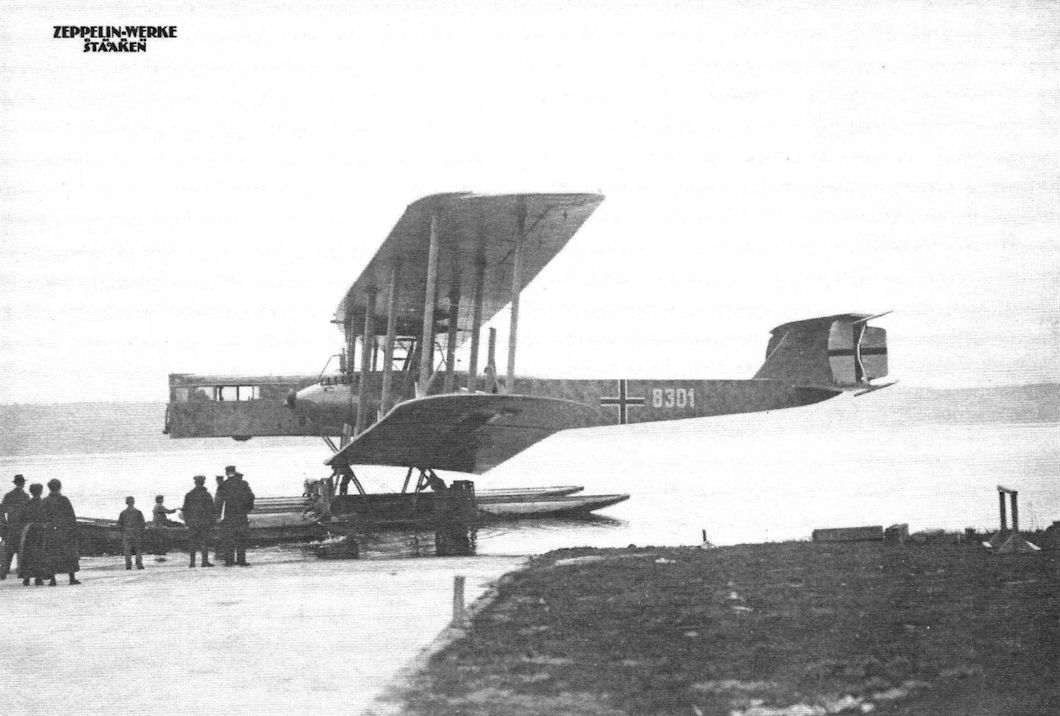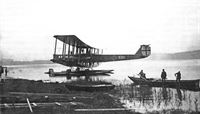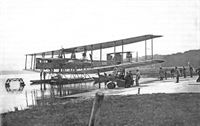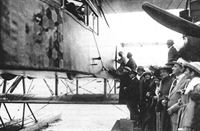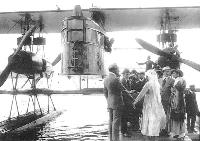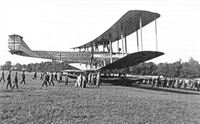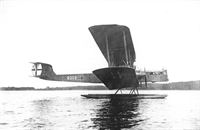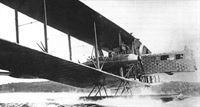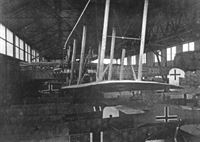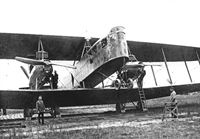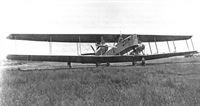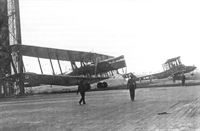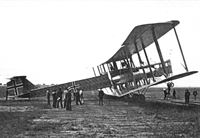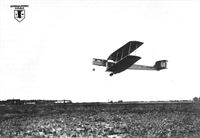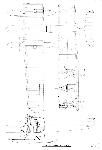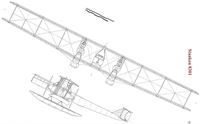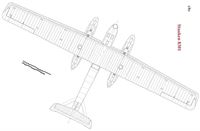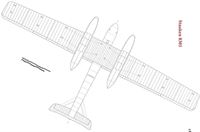В.Обухович, А.Никифоров Самолеты Первой Мировой войны
В конце войны появился самолет 8 301, по существу тот же R XVI, но с фюзеляжем, подвешенным между крыльями и без носовой опоры. В качестве бомбардировщика его применить не успели, но после войны он летал на гражданских авиалиниях. Испытывался также морской бомбардировщик Rs I - вариант 8 301 на поплавковом шасси. Экипаж гидросамолета состоял из 5 человек. Вооружение включало три подвижных пулемета и 20-мм пушку. Продолжительность полета была доведена до 10 часов.
Показать полностью
O.Thetford, P.Gray German Aircraft of the First World War (Putnam)
Zeppelin-Staaken Type 8301 Seaplane
Three seaplanes of this type were completed, Naval Nos. 8301, 8303 and 8304; the completion of 8302 is not confirmed. Although an R VI type wing cellule was used, with balanced ailerons, a completely new fuselage was designed and suspended almost midway between the wings. The tail surfaces employed were as those on the R XIV and R XV land machines. Engines, four 260 h.p. Mercedes D IVa. Span, 42.2 m. (138 ft. 5 5/8 in.). Length, 21 m.(68ft. 10 7/8 in.). Height, 6.8 m. (22 ft. 3 3/4 in.). Area, 340.5 sq.m. (3,677 sq.ft.). Weights: Empty, 9,000 kg. (19,800 lb.). Loaded, 12,500 kg. (27,500 lb.). Speed, 130 km.hr. (81.25 m.p.h.). Climb, 3,000 m. (9,840 ft.) in 54 min. Duration, 10 hr. Armament, five machine-guns.
Zeppelin-Staaken Type 8301
Naval seaplane No. 8301 underwent flight trials fitted with land undercarriage chassis. Engines, four 260 h.p. Mercedes D IVa. Dimensions were same as for seaplane except for height, which would naturally be less, and wing area was the same. No other data available.
Показать полностью
G.Haddow, P.Grosz The German Giants (Putnam)
Staaken 8301 and 8303 Types
In December 1917 the German Navy placed an order for two Staaken seaplanes, numbered 8301-8302, followed in January 19 18 by an additional order for four slightly-improved seaplanes numbered 8303-8306. The design of these machines incorporated the lessons learned from the extensive Staaken L test programme. Although the general layout remained unchanged, a major modification consisted of raising the fuselage several feet above the lower wing as in the Bristol Fighter. By raising both fuselage and tail farther above the water, they were better protected from the spray and buffeting of rough seas. The forepart of the fuselage was modified to bring the nose gun ring level with the upper longerons to provide more space in the nose compartment. Cellon windows ran around the entire nose, providing an unobstructed view in all directions. The nose compartment just forward of the two pilots' seats contained the bomb-release mechanism for the ten 10 kg. bombs which were stored in two containers along each side of the nose. Also located in the nose was an anchor winch and sufficient line for hoisting a small anchor which was hung externally in front. A collapsible mast antenna made it possible to transmit signals while the machine was afloat.
In all other respects the Staaken 8301 and 8303 machines made use of the refinements found on the latest Staaken land R-planes. The wings and their control surfaces resembled the wings of the Staaken R.XIV, and the tail was fitted with aerodynamically-balanced elevators. As in the R.XIV, machine-gun positions were placed in the upper wings and in the usual ventral and dorsal locations. Provision was made to mount two 20 mm. Becker cannons in the rear positions. The 20 mm. Becker had been experimentally fitted to smaller German naval aircraft and was reputed to be very effective against small ships, submarines and aircraft. The crew consisted of five men, less than the complement of the Staaken landplanes. The reduction in weight permitted more fuel to be carried and the 8301 and 8303 types were equipped with twelve 300 litre fuel tanks, which provided for a duration of 9-10 hours cruising on all four engines.
The Staaken 8301 made its first flight in the summer of 1918 as a landplane. For this purpose, it was fitted with a standard-wheeled undercarriage, such as was installed on other Staaken landplanes. However, the auxiliary nose gear had to be lengthened to allow for the higher location of the fuselage. After completion of initial trials, the 8301 was mounted on duraluminium floats that were slightly longer and differently suspended than on the Staaken L. The floats were divided into twelve air-tight compartments to localize flooding in case of damage.
The 8301 and later the 8302 were based at Warnemunde for naval tests. This testing programme was halted at the end of the war, and it is believed the machines were not accepted by the Navy. After the war an Allied naval commission, inspecting German bases, was impressed by the overwhelming size of the 8301 and 8302, and described them as dwarfing the 200-odd aircraft stationed at Warnemunde.
The slightly improved 8303 series, ordered shortly after the 8301, was never delivered, but two completed machines, the 8303 and 8304, were found in the Staaken seaplane hangar at Wildpark near Potsdam by the Inter-Allied Control Commission. It should be noted that the not always reliable I.A.C.C. report claimed that three Staaken R-seaplanes were destroyed in tests. The most notable modification possessed by the 8303 types was the return to swept-back wings similar to the Staaken R.XIV.
In the early post-war period 8301 and possibly 8303 and 8304 were used on regular weekend passenger excursions between Berlin and Swinemunde, a popular German coastal resort.
The Staaken R-seaplanes were by far the largest floatplanes ever constructed. Sikorsky had mounted his "Ilia Mourometz" on floats for the Imperial Russian Navy in 1914-15, and Caproni produced a floatplane version of his famous triplane, but neither aircraft approached the Staaken machines in size. Since 1917 there may have been floatplanes which exceeded the Staaken machines in weight, but no record has been found of a floatplane with greater wingspan than the Staaken seaplanes.
Colour Scheme and Markings
All machines were finished overall with printed camouflage fabric using rather small polygons. Narrow Latin crosses edged in white and spanning the full wingtip chord and depth of fuselage were carried. On the rear fuselage the naval number was painted in large white figures.
SPECIFICATIONS
Type: Staaken 8301 and 8303
Manufacturer: Zeppelin-Werke G.m.b.H., Staaken, Berlin
Engines: Four 260 h.p. Mercedes D.IVa engines
Dimensions:
Span, 42•2 m. (138 ft. 5 1/2 in.)
Length, 21 m. (68 ft. 10 1/2 in.)
Height, 6•8 m. (22 ft. 3 1/2 in.)
Areas: Wings, 340•5 sq. m. (3663 sq. ft.)
Weights:
Empty, 9000 kg. (19,845 lb.)
Loaded, 12,500 kg. (27,563 lb.)
Performance:
Maximum speed, 130 km.h. (80,8 m.p.h.)
Climb, 3000 m. (9843 ft.) in 54 mins.
Service Use: None
Показать полностью
J.Herris Zeppelin-Staaken Aircraft of WW1. Vol 1: VGO.1 - R.IV R.29/16 (A Centennial Perspective on Great War Airplanes 47)
Staaken Specifications
Type R.XVI L 8301 & 8303
Engines 2x500 Hp Benz Bz.VI 2x220 Hp Benz Bz.FV 4x260 Hp Mercedes D.IVa 4x260 Hp Mercedes D.IVa
Span 42.2 m (138' 5 1/2") 42.2 m (138' 5 1/2") 42.2 m (138'5 1/2")
Chord (max.) - 4.53 m( 14' 10") -
Gap (max.) - 4.55 m (14' 11") -
Length 22.5 m (73' 10") 22.2 m (72' 10") 21 m (68' 10 1/2")
Height 6.5 m (21'4") 7.38 m (24' 2 1/2") 6.8 m (22'3 1/2")
Wing Area 340 m2 (3,658 ft2) 360 m2 (3,874 ft2) 340.5 m2 (3,663 ft2)
Wt. Empty 10,400 kg (22,932 lb.) 8,400 kg (18,522 lb.) 9,000 kg (19,845 lb.)
Wt. Fuel - 2,445 kg (5,391 lb.) -
Wt. Loaded 14,650 kg (32,303 lb.) 11,800 kg (26,019 lb.) 12,500 kg (27,563 lb.)
Max Speed 130 km/h (80.8 m/h) 125 km/h (77.7 m/h) 130 km/h (80.8 m/h)
Climb 1,000 m - 23.7 minutes (full load) -
Climb 1,780 m - 60 minutes -
Ceiling 3,710 m 2,500 m -
Duration - 10 hours -
The Staaken L & 8301/8303 were naval floatplanes derived from the R.VI. The 8301 & 8303 could climb to 3,000 m in 54 minutes.
Показать полностью
J.Herris Zeppelin-Staaken Aircraft of WW1. Vol 2: R.VI R.30/16 - E.4/20 (A Centennial Perspective on Great War Airplanes 48)
Staaken 8301 & 8303
Staaken's R-floatplane family did not stop with the Staaken L; it had been successful enough that the Navy ordered additional aircraft. In December 1917 the Navy ordered two developments of the Staaken L, given Marine Numbers 8301 and 8302. The next month the Navy ordered two slightly improved aircraft, Marine Numbers 8303 and 8304. These four aircraft were improved developments of the Staaken L with modifications based on the lessons learned from evaluating that aircraft.
These aircraft were very similar to the Staaken L, with the most visible difference being the fuselage was raised above the lower wing. Raising the fuselage and tail higher above the water improved the sea keeping. The forward gun ring was raised level with the top of the fuselage, giving the aircraft a rectangular nose profile.
Windows of Cellon were installed around the nose giving a wide field of view. The nose also had the bomb releases for ten 10 kg bombs stored in two containers along each side of the nose. An anchor winch was installed there for a small anchor hung externally on the nose. A mast antenna enabled the radio to transmit while the aircraft was on the surface and was collapsible for flight.
Other improvements to the 8301/8303 over the Staaken L were derived from the modifications introduced by the newer Staaken landplanes. The wing and control surfaces resembled the R.XIV and the tail had balanced elevators. Becker 2 cm cannon were planned for the rear gun positions. The five-man crew, less then that for the R.VI, reduced the weight to enable the larger fuel load to be carried. Twelve 300-liter fuel tanks gave an endurance of 9-10 hours at cruising speed on all four engines.
In the summer of 1918 the 8301 made its maiden flight as a landplane. The wheeled landing gear resembled that of the standard Staaken R-planes except that the raised fuselage meant the nose landing gear had to be longer. All-duralumin floats were then fitted; these were longer than those on the Staaken L and divided into 12 compartments to minimize flooding in case of damage.
The 8301 and 8302 were based at Warnemunde for evaluation until the Armistice.
The 8303 and 8304 were completed but not delivered; postwar they were found at the Staaken seaplane hangar at Wildpark near Potsdam by the IAACC. The most visible difference between the 8301/8302 and the 8303/8304 is the later aircraft had slightly swept wings. Postwar, the 8301 and perhaps the 8303 and 8304 were used on regular weekend passenger flights between Berlin and Swinemunde.
These Staaken floatplanes are the largest, though not the heaviest, floatplanes ever built.
Показать полностью
M.Dusing German Aviation Industry in WWI. Volume 2 (A Centennial Perspective on Great War Airplanes 85)
Zeppelin-Werke GmbH, Staaken near Spandau (Berlin) (Staak)
Aircraft Development:
<...>
Staak 8301 and later Staak 8302 were sent to Warnemunde for naval trials. The testing program for these aircraft was interrupted by the end of the war and it is believed that the Navy did not accept these machines for service. After the war, an Allied naval commission inspecting German naval bases was struck by the gigantic size of the Staak 8301 and Staak 8302.
Shortly after the Staak 8301/8302, a slightly improved Staak 8303 series was ordered, which was never delivered to the fleet. Two completed machines, Staak 8303 and Staak 8304, were discovered by the Inter-Allied Control Commission (I.A.C.C.) in the Staaken seaplane hangar at Potsdam's Wildpark. It should be noted that one I.A.C.C. report, which was not always reliable, claimed that three Staaken R-class seaplanes crashed during the tests. The most notable change that distinguished the Staaken 8303 was the return to a small sweep wing similar to that fitted to the Staak R.XIV.
The Staak floatplanes 8301 thru 8304 were the largest, though not the heaviest, floatplanes ever built.
Показать полностью
